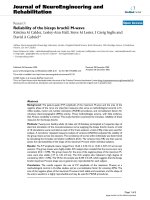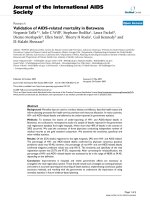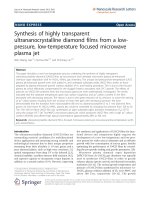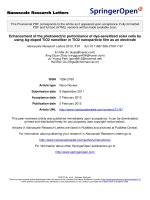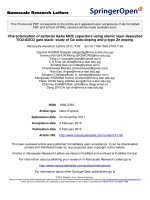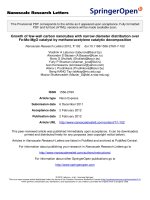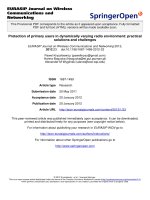Báo cáo toán học: " Structure of reverse microemulsion-templated metal hexacyanoferrate nanoparticles" ppt
Bạn đang xem bản rút gọn của tài liệu. Xem và tải ngay bản đầy đủ của tài liệu tại đây (1.87 MB, 22 trang )
This Provisional PDF corresponds to the article as it appeared upon acceptance. Fully formatted
PDF and full text (HTML) versions will be made available soon.
Structure of reverse microemulsion-templated metal hexacyanoferrate
nanoparticles
Nanoscale Research Letters 2012, 7:83 doi:10.1186/1556-276X-7-83
Alberto Gutierrez-Becerra ()
Maximiliano Barcena-Soto ()
Victor Soto ()
Jesus Arellano-Ceja ()
Norberto Casillas ()
Sylvain Prevost ()
Laurence Noirez ()
Michael Gradzielski ()
Jose I Escalante ()
ISSN 1556-276X
Article type Nano Express
Submission date 3 October 2011
Acceptance date 20 January 2012
Publication date 20 January 2012
Article URL />This peer-reviewed article was published immediately upon acceptance. It can be downloaded,
printed and distributed freely for any purposes (see copyright notice below).
Articles in Nanoscale Research Letters are listed in PubMed and archived at PubMed Central.
For information about publishing your research in Nanoscale Research Letters go to
/>For information about other SpringerOpen publications go to
Nanoscale Research Letters
© 2012 Gutierrez-Becerra et al. ; licensee Springer.
This is an open access article distributed under the terms of the Creative Commons Attribution License ( />which permits unrestricted use, distribution, and reproduction in any medium, provided the original work is properly cited.
- 1 -
Structure of reverse microemulsion-templated metal hexacyanoferrate
nanoparticles
Alberto Gutiérrez-Becerra
†1
, Maximiliano Barcena-Soto
†1
, Víctor Soto
†1
, Jesús
Arellano-Ceja
†1
, Norberto Casillas
†1
, Sylvain Prévost
†2
,
Laurence Noirez
†3
, Michael
Gradzielski
†2
, and José I Escalante*
1
1
Chemistry Department, University of Guadalajara, Boul. M. García Barragán # 1451,
Guadalajara, Jalisco, 44430, Mexico
2
Stranski-Laboratorium für Physikalische und Theoretische Chemie, Institut für
Chemie, Technische Universität Berlin, Straße des 17. Juni 124, Sekr. TC7, Berlin,
10623, Germany
3
Laboratoire Léon Brillouin (CEA-CNRS), CEA Saclay, Gif-sur-Yvette, 91191,
France
*Corresponding author:
†
Contributed equally
Email addresses:
AG-B:
MB-S:
VS:
JA-C:
NC:
SP:
LN:
MG:
JIE:
Abstract
The droplet phase of a reverse microemulsion formed by the surfactant
cetyltrimethylammonium ferrocyanide was used as a matrix to synthesize
nanoparticles of nickel hexacyanoferrate by adding just a solution of NiCl
2
to the
microemulsion media. Dynamic light scattering and small-angle neutron scattering
measurements show that the reverse microemulsion droplets employed have a
globular structure, with sizes that depend on water content. Transmission electron
microscopy and electron diffraction are used to obtain information about the structure
of the synthesized nanoparticles. The results show that the size and shape of the
coordination compound nanoparticles correspond with the size and shape of the
droplets, suggesting that the presented system constitutes an alternative method of the
synthesis of metal hexacyanoferrate nanoparticles.
Keywords: reverse micelles; template method; nanoparticles; nickel
hexacyanoferrate.
- 2 -
Background
Microemulsions represent thermodynamically stable liquid dispersions containing
surfactant aggregates, which can often be found in a large region of the phase diagram
of two- or multicomponent surfactant systems [1, 2]. They exhibit a well-defined
structure that is characterized by a typical correlation length in the nanometer scale.
Such microemulsions are of special interest because a variety of reactants can be
introduced into the nanometer-sized aqueous domains, leading to materials with
controlled size and shape [3-9]. Such characteristics play pivotal roles in controlling
the physical, chemical, optical, and electronic properties of these nanomaterials. In the
past few years, significant research has been conducted in the reverse microemulsion-
mediated synthesis of inorganic (metal halides, selenides, or sulfides) and organic
(cholesterol, rhodiarome, rhovanil, nimesulide, etc.) nanoparticles [3-13], and there
has been substantial progress in the characterization of microemulsions of various
types [14].
The synthesis of nanoparticles by reverse microemulsions is viable and attractive
because it does not only produce nanoparticles that have a narrow size distribution,
but also the particle size can be controlled by varying the microemulsion composition
[15]. The reaction in a microemulsion may be conducted in two modes: (1) a multiple
microemulsion method, where two or more microemulsions, each containing one
reactant, are mixed together [16]. Upon mixing, the droplets collide with one another
as a result of the Brownian motion. These collisions lead to the formation of product
monomers [7, 17, 18]. Nucleation takes place in a given droplet when the number of
product monomers exceeds the critical nucleation number [19-21]. Further collisions
between a droplet carrying a nucleus and another one carrying the product monomers
cause the growth of the nucleus [19, 22]; (2) in the simple addition type, the reducing
or precipitating reagent is directly added to the microemulsion containing the other
reactant [23, 24], i.e., this mode promotes intramicellar nucleation and growth [22,
25]. When particles are formed in single microemulsions, their size and polydispersity
are controlled by one or more of the following mechanisms: reaction kinetics,
intramicellar nucleation and growth, intermicellar nucleation and growth, and particle
aggregation [26, 27]. A variation of this synthetic path could proceed by replacing the
counterion of the surfactant, and only then the addition of a salt to this reverse
microemulsion media. This last method has been successfully used to synthesize
nanoparticles using the anionic surfactant AOT [28], for instance, for the case of
cobalt ferrocyanide salt nanoparticles [29]. However, to the best of our knowledge,
there is no report on the modification of cationic surfactants with ionic coordination
compounds such as the cetyltrimethylammonium ferrocyanide [CTAFeII].
Some advantages of this novel cationic surfactant are readily apparent; for
instance, inverse microemulsion formed with this surfactant will allow synthesizing
different transition metal hexacyanoferrates [Mhcf] by simply adding different salts to
the microemulsion media, i.e., with the same surfactant, it is possible to produce
different nanoparticles of coordination compounds (M
II
hcf or M
III
hcf). Such
compounds and other Prussian blue analogues have been a subject of several studies
because of their promising characteristics which include electrochromism, the ability
to mediate (electrocatalyze) redox reactions, ionic and electronic (mixed valence
electron hopping) conductivities, capability for storage of countercations, and
molecular magnetism [30-32].
- 3 -
According to this motivation, in this paper, we studied the formation of a novel
type of ferrocyanide-containing cationic surfactant and its ability to form reverse
microemulsions. In this work, we use as surfactant a mixture of
cetyltrimethylammonium bromide [CTAB] (95 wt.%) and CTAFeII (5 wt.%). The
latter was prepared by replacing the bromide (Br
−
) ions of the cationic surfactant
CTAB with ferrocyanide ([Fe(CN)
6
]
4−
) ions following a direct metathesis reaction in
an aqueous phase [33]. This new surfactant, CTAFeII, presents a very limited area for
a microemulsion phase, so when the mixture of surfactants was used, we reach a more
extended region of the microemulsion. This can be explained taking into account the
interfacial stiffness caused by the bulky molecules of CTAFeII (a huge counterion and
four aliphatic chains). However, by adding CTAB molecules, it was possible to obtain
an improvement in the interface flexibility. In addition, by changing the surfactant
ratio of the mixture, it was found that the system offers better results to the
nanoparticle synthesis when a low concentration of CTAFeII (5 wt.%) was used in the
surfactant mixture. Furthermore, López-Quintela established that smaller
nanoparticles can be obtained in microemulsions when there is a significant difference
in the concentrations of the reactants [7].
Materials and methods
Materials
All the reactants used in this report were of analytical grade. CTAB was purchased
from Sigma-Aldrich Corporation (99%; St. Louis, MO, USA), ferrocyanide salt
(K
4
[Fe(CN)
6
]·3H
2
O), from J.T. Baker (99%; Deventer, The Netherlands), n-hexane
(C
6
H
14
) and NiCl
2
·6H
2
O, from Caledon Laboratories Ltd. (98% and 99%,
respectively; Halton Hills, Canada), n-butanol (C
4
H
9
OH), from Productos Químicos
Monterrey (99%; Monterrey, Nuevo León, Mexico), and double distilled water, from
Selectropura S.A. de C.V. (σ = 1.5 to 3 µS/cm; Guadalajara, Jalisco, Mexico). For
neutron scattering experiments, D
2
O (99.9% D; Euriso-Top, Gif-sur-Yvette, France)
was used instead of H
2
O to increase the contrast and lower the background.
Synthesis of modified surfactant
The surfactant CTAFeII was prepared by a direct metathesis reaction in an aqueous
phase. The detailed procedure is described in the study of Gutierrez-Bercerra et al.
[33]. Functional groups of CTAB and CTAFeII were identified by a Fourier transform
infrared [FTIR] spectrometer (Spectrum One, PerkinElmer, Waltham, MA, USA).
Infrared spectra were recorded in the 400- to 4,000-cm
−1
region, with a resolution of
4.00 cm
−1
.
Phase diagram
The pseudo-ternary phase diagram for the CTAB + CTAFeII + n-butanol/n-
hexane/water system was constructed, considering as surfactant a mixture of CTAB,
CTAFeII, and n-butanol, using W
CTAB
/W
CTAFeII
ratios of 0.95:0.05 and the (W
CTAB
+
W
CTAFeII
)/W
but
ratio of 1, where W
CTAB
, W
CTAFeII
, and W
but
are the weights of CTAB,
CTAFeII, and n-butanol, respectively. A simple titration technique was used to
construct the diagram. Microemulsions were prepared by mixing weighed appropriate
amounts of the individual components. The amount of n-hexane (W
hex
) in the
surfactant mixture determines the H value (H = [W
CTAB
+ W
CTAFeII
+ W
but
] / [W
hex
+
W
CTAB
+ W
CTAFeII
+ W
but
]), while W
w
= W
water
/ (W
water
+ W
hex
+ W
CTAB
+ W
CTAFeII
+
W
but
) represents the weight fraction of water used as the titration component. Water
- 4 -
was added in small volumes under permanent stirring in a tightly closed vial to avoid
evaporation. Then, the vials were placed in a thermostatic bath (25°C) until a
homogeneous media is reached.
Dynamic light scattering
Dynamic light scattering [DLS] measurements were performed using an ALV/CGS-3
goniometer with an ALV/LSE-5004 multiple tau digital correlator (ALV-Laser
Vertriebsgesellschaft m-b.H., Langen, Germany). The light source was an He-Ne
laser operating at a wavelength of 633 nm. The homodyne intensity autocorrelation
function g
(2)
(τ) was measured at 90°. Data analysis was performed with the
normalized intensity autocorrelation function using a third-order cumulant fit [34] that
yielded as key parameter the effective collective diffusion coefficient.
Small-angle neutron scattering
Small-angle neutron scattering [SANS] measurements were done on the instrument
PAXY at Laboratoire Léon Brillouin, Gif-sur-Yvette, France. A wavelength of 0.5 nm
(FWHM 10%) was selected, and two configurations were used with sample-to-
detector distances of 1.25 and 5.05 m.
Synthesis of nickel hexacyanoferrate
The synthesis of nickel hexacyanoferrate [Nihcf] nanoparticles was carried out at H =
0.4 and W
w
= 0.09. Appropriated amounts of CTAFeII, CTAB, n-butanol, and hexane
were mixed until an H value of 0.4 was reached, and then it was maintained under
stirring. After that, as an aqueous phase, a solution of 5 mM NiCl
2
was added to the
mixture to reach W
w
= 0.09. The microemulsion formed was stable for several days
and at the same time maintaining a transparent state. Nihcf nanoparticles were
separated from the microemulsion media by centrifugation at 9,000 rpm for 10 min.
The precipitate was then washed several times with acetone. Despite the washing
process, a small quantity of CTAB remained mixed with the nanoparticles. To obtain
transmission electron microscopy [TEM] micrographs (JEM-1010, JEOL de Mexico
S.A. de C.V., Mexico City, Mexico), a drop of the nanoparticles dispersed in acetone
was placed directly on a carbon-coated copper grid. X-ray diffraction [XRD] patterns
were recorded with a STOE Theta/theta X-ray diffractometer (STOE & Cie GmbH,
Darmstadt, Germany) using a CuKα (λ = 0.15406 nm) at room temperature. FTIR
spectra of the Nihcf were carried out in a PerkinElmer Spectrum One spectrometer.
Results and discussion
Surfactant characterization
For comparison, the IR spectra of the surfactants CTAB and CTAFeII are shown in
Figure 1. The symmetric (υ
s
(CH
2
), d
+
) and asymmetric (υ
as
(CH
2
), d
−
) stretching
vibrations of pure CTAB indicate equivalent gauche defects which lie at 2,849 and
2,918 cm
−1
[35], as well as those of CTAFeII. The peaks at 3,017 and 1,487 cm
−1
, and
at 1,473 and 1,462 cm
−1
were attributed to the asymmetric and symmetric C-H
scissoring vibrations of CH
3
-N
+
moieties and to the CH
2
scissoring mode, respectively
[36]. The above mentioned results indicate that both surfactants possess a long
aliphatic chain with a positively charged polar head as expected for the hydrocarbon
CTAB structure. On the contrary, two peaks only appear in the CTAFeII: at 595 cm
−1
due to the Fe-C vibration and at around 2,000 to 2,100 cm
−1
due to the C≡N stretching
[37]. Hence, it confirms that indeed the ferrocyanide ion is present in the CTAFeII.
- 5 -
The low-spin Fe(II) is diamagnetic and will thus not have electronic transitions. The
absorptions near 1,500 and between 1,550 and 1,700 cm
−1
can be attributed to
overtones and combination tones of OH
−
and H
2
O fundamental vibrations. The much
lower reflectivity of the CTAFeII is a consequence of the high water content, which
produces intense absorption with a broad band near 1,550 and 1,700 cm
−1
because of
the water present. In order to quantify this amount of water in CTAFeII samples, Karl
Fisher titrations were carried out, obtaining a 2.8% in weight.
Phase behavior
The pseudo-ternary phase diagram obtained for the CTAB + CTAFeII + n-butanol/n-
hexane/water at 25°C is shown in Figure 2A. The boundary between the
microemulsion and the non-microemulsion region was established by a systematic
titration based on the clear-turbid observation and conductivity measurements (not
shown here). This microemulsion region is transparent because of the small dispersion
size of water droplets in the system. Outside this area, the mixture is turbid, indicating
that the system reaches the solubilization boundary for water and forms big emulsion
droplets. In order to study the influence of alcohol, in addition, a phase diagram with
n-pentanol as cosurfactant was obtained (see Figure 2B). The reverse microemulsion
region of both phase diagrams is reached at a similar composition but is more
extended for the case of pentanol. Obviously, the effectiveness of the cosurfactant
increases with increasing chain length, an effect that is typically observed for the
formation of microemulsions induced by the addition of a cosurfactant [38, 39]. This
indicates that the water solubility has no strong dependence on the type of alcohol and
that similar conditions prevail at the amphiphilic interface of the microemulsion
aggregates for butanol and pentanol. On the other side, by comparing the phase
diagrams in Figure 2C, it is seen that the microemulsion region for the mixture of
surfactants examined is much larger than the microemulsion region shown for
CTAFeII. This shows that the mixture of surfactants favors larger solubilization of
water compared to the pure CTAFeII surfactant.
Structural characterization
Figure 3 shows a representative plot of the correlation function g
(2)
(τ)-1 obtained for
the microemulsions studied. The solid line is a fit to the data using the cumulant
method [34]. For a reverse micellar solution, the third-order cumulant expansion of
g
(2)
(τ)-1 varies linearly with 2q
2
τ. From the slope, the effective collective diffusion
coefficients [D
eff
] were determined. As a first approximation to determine the droplet
size, we considered that the microemulsion is formed by non-interacting droplets. In
this condition, the hydrodynamic radius [R
h
] can be calculated by the Stokes-Einstein
equation
h eff
/ 6
R kT D
πη
=
, where k is the Boltzmann constant, T, the temperature,
and η, the solvent viscosity (the continuous phase in the case of microemulsions). The
obtained radii (2.5 to 4.5 nm) are in the same range as those measured by SANS,
proving that the non-interacting supposition can be applied in this system without
significant error. D
eff
and R
h
depend on the H values (see inset in Figure 3, and Table
1), with larger droplets being present for smaller H. An explanation could be that by
increasing the hexane content, less butanol is present at the amphiphilic interface (as it
becomes dissolved in oil, whereas CTAB and CTAFeII should not be soluble in
hexane to any significant extent). Thereby, the total amphiphilic interface available
becomes smaller, which then explains the increase in size for a given amount of
water. The R
h
is also proportional to the relative amount of water contained as
demonstrated in earlier works [40, 41].
- 6 -
SANS was applied for obtaining a more comprehensive structural picture in the
relevant size range that, for our given q range, is about 0.5 to 15 nm, where q
(
0
4 sin( / 2) /
q
π θ λ
=
, here, λ
0
and θ are the wavelength and the scattering angle,
respectively) can be interpreted in terms of distances using
2 /
d q
π
=
. The obtained
scattering curves as a function of q are given in Figure 4. At a low amount of water,
the spectra have a low intensity. With increasing W
w
, the scattering intensity increases
and a pronounced angular dependence develop. Apparently, the water core of the
aggregates is now large enough to produce a noticeable scattering and is becoming
bigger with increasing water content. The shape of the scattering curves at higher q
already indicates that these reverse microemulsions have a globular structure.
In addition, a correlation peak is visible that becomes much more prominent with
increasing water content in the reverse microemulsion, and at the same time, its
maximum moves from 1.4 to 0.85 nm
−1
(for a fixed H of 0.5). This, together with the
intensity increase, shows that the aggregates grow substantially in size with increasing
water content, where, however, it should be noted that in SANS basically, only the
D
2
O core is visible as an aggregate due to the strong contrast between the two
isotopes H and D.
The pronounced correlation peak has to be due to steric interactions between the
reverse aggregates as electrostatic interactions in the oil-continuous medium should
be negligible, but of course, at the concentrations employed, the volume fractions of
the amphiphilic material (CTAB, CTAFeII, n-butanol) plus D
2
O are in the range of
34% to 59% v/v and therefore high enough to explain effective repulsion already on
the basis of purely steric interactions. In addition, it is well known that in reverse
microemulsions, the solvent oil molecules are to a certain extent bound to the reverse
microemulsion aggregates [42, 43], thereby enhancing the effective volume fraction
further.
The first analysis of the SANS data can be performed using the peak position q
Peak
to determine the number density
1
N of aggregates assuming simple cubic packing:
1 1/3
Peak
2 / q N
π
−
=
. Then, it can be recalled that
1
N can be expressed with the volume
fraction Φ of the aggregated material and the volume of one aggregate V:
/
N V
= Φ
.
Assuming spheres, a radius can be deduced. Depending on the choice of material to
consider, either only D
2
O or the whole aggregated material (D
2
O, n-butanol,
surfactant), two values are found that can be considered as values for the core
(neglecting dissolved butanol) and for the entire droplet (neglecting the contribution
from oil swelling the aliphatic chains of the surfactant); the core radius varies from
0.8 to 3.1 nm and is proportional to the water content of the microemulsion. The
difference between the core and the overall radius is in all cases around 1.1 nm (1.03
to 1.25 nm), a reasonable value for the surfactant acting as a shell; taking into account
the solvation of this shell by hexane, a higher value would be reached; using Tanford's
length, the stretched C15 chain is 2.05 nm; the typically retained value of 75% to 80%
of this elongation corresponds to lengths of 1.54 to 1.64 nm; the radius of the
tetramethylammonium head group is 0.285 nm; the overall thickness expected for the
swollen shell would then be 2.11 to 2.21 nm. However, notice that the R
h
, obtained by
DLS and SANS, increases roughly linear with the water content as typically observed
for reverse microemulsion droplets [44-46].
- 7 -
Two-dimensional data were reduced using BerSANS accounting for dead time,
transmission, and background scattering assimilated to the empty cuvette (which
means that the incoherent scattering in the spectra still contains contributions from all
compounds in the samples including the solvent), and the scattering from H
2
O in a 1-
mm cuvette was used to account for the detector pixel efficiency and solid angle
variations. Absolute scale was deduced from the evaluation of the direct beam flux.
As all corrected scattering patterns are isotropic, they were finally radial-averaged,
and data from two configurations were merged.
The whole scattering curves can be described by a model of globular aggregates
interacting via an effective hard sphere potential for which the scattering intensity is
given by:
(
)
2
1
p s
( ) SLD SLD ( ) ( )
I q N P q S q
= ⋅ − ⋅ ⋅ , (1)
where
1
N is the number density of particles, SLD
p
and SLD
s
, the scattering length
densities of the particle and the solvent, respectively, P(q), the particle form factor
assuming core-shell spheres, and S(q), the structure factor accounting for the
interparticle interactions, keeping the same density number and using an adjustable
hard sphere radius. The core is composed of D
2
O and butanol; the shell of polar
charged moieties is composed of D
2
O, butanol, and counterions (bromide is known to
adsorb strongly on alkylammonium interfaces, and the amount of ferrocyanide ions is
negligible); and the matrix contains hexane and the aliphatic chains of the surfactants
(Table 2). The shell thickness was fixed to the dimension of -CH
2
-N(CH
3
)
3
+
which is
0.57 nm [47]. The incompressibility of all the species was assumed as we do not have
access to apparent molecular volumes in situ.
To evaluate the feasibility of this model, where butanol is absent from the oil phase
and partitions between the core and the shell, a comparison of the experimental
invariants
2
exp inc
0
INV ( ( ) )
I q I q dq
∞
= −
∫
with the theoretical invariants
2
oil shell oil shell
2 2
th oil core oil core
2
core shell core shell
(SLD SLD )
INV 2 (SLD SLD )
(SLD SLD )
φ φ
π φ φ
φ φ
−
= + −
+ −
(2)
was performed with the partition coefficient of butanol between the core and the shell
as the only adjustable parameter; the volume fraction of water in the shell was fixed to
be identical to the volume of the tetraalkylammonium group (ca. four water molecules
per group). Identity was found with the partition of butanol toward the water phase
increasing with the amount of D
2
O, except in two cases where the amount of water
was too little to actually allow for a core. The maximum volume fraction of butanol in
the core does not exceed 16%, only slightly higher than the solubility limit of the
alcohol in bulk water (9.5%). Accordingly, we think that our model is reasonable and
self-consistent. In all cases, we observe a very good agreement between the values for
the droplet core obtained by the analysis of the peak position and by the full fits
(Table 3).
- 8 -
Synthesis of nanoparticles
The formation of Nihcf nanoparticles in this system was carried out in four principal
stages as depicted in Figure 5. First, the dissociation of the surfactant counterions
(ferrocyanide and bromide) is reached when the solution of NiCl
2
is added (dropwise
under vigorous stirring) to the reverse microemulsion. Then, the nickel and
ferrocyanide ions react to form the first nuclei of Nihcf. Once the nuclei are formed,
further growth of the particles is taking place via collisions with other microemulsion
droplets containing additional salt precursors. Size and shape of nanoparticles are
controlled by the steric stabilization provided by adsorbed surfactant molecules on the
surface of the nanoparticles [48]. This prospective mechanism still has to be
confirmed in more detail by further studies that are currently going on.
The reaction between [Fe(CN)
6
]
4−
ions and the CTAFeII and nickel(II) ions from
the aqueous solution produces a colored (yellowish brown) microemulsion without
precipitation, suggesting that this reaction is sufficiently facile to allow for the
formation of Nihcf, while suppressing at the same time the further growth due to
surfactant stabilization of the nanoparticles. Accordingly, the formed particles remain
in the nanometer range and are colloidally dispersed (see Figure 6). The inset in this
figure shows the indexing of the electron diffraction pattern of the sample with a
[040] direction that coincides with the space group F43m characteristic of the Nihcf
[49]. Figure 6 confirms the existence of small particles (approximately 6 nm in
average size) which have a homogeneous size distribution and correspond to the
droplet size of the initial microemulsion droplets (as measured by DLS and SANS).
XRD and FTIR were performed in order to obtain a better characterization of the
Nihcf nanoparticles. Figure 7A shows a comparison between the FTIR spectra of the
stretching vibration of the cyano group in the Nihcf nanoparticles (solid line) and the
surfactant CTAFeII (dashed line). The absorption band at 2,109 cm
−1
can be assigned
to the stretching vibration of the C≡N group into the CTAFeII. While for the Nihcf
nanoparticles, this absorption band shifts to 2,096 cm
−1
and represents the stretching
vibration of the cyano group into the cyanoferrate lattice of Nihcf nanoparticles [Ni
2+
-
C≡N-Fe
2+
] [50]. On the other hand, Figure 7B shows the XRD pattern of Nihcf
nanoparticles mixed with CTAB remained from the washing process. In order to
isolate the Nihcf nanoparticle contribution in the diffractogram, the peaks assigned to
the diffraction of CTAB [51] were subtracted. The lattice parameter value for the
nanoparticles calculated by indexing the peak position using an F43m lattice
symmetry is 1.016 nm, close to the 1.000 nm reported elsewhere [49].
An advantage identified in this work for the synthesis of coordination compound
nanoparticles is that with this system, different transition Mhcf can be obtained only
by varying the transition metal (copper(II), cobalt(II), iron(III), etc.) in the aqueous
phase. This constitutes an alternative method using cationic, modified surfactants in
reverse microemulsion for the synthesis of this type of nanoparticles.
Conclusions
In this work, the preparation of nanoparticles of transition Mhcf with a homogeneous
size was performed using a simple process in which a droplet is regarded as a
nanoreactor. Such soft technique provides good crystallinity in the absence of high
temperature and pressure requirements, which favors the formation of small
nanoparticles with controlled size and size distribution. Furthermore, it was found that
- 9 -
the nanostructure of the particles obtained seems to be related to the structure of the
template involved, namely the spherical water pool, at the conditions mentioned in
this work.
The ratio of water to surfactant concentration plays an important role in
determining the interaction of the water pool with the surfactant or bulk water. Hence,
the size of the reverse microemulsion droplets increases as the water pool increases
and vice versa. By varying the amount of water content, change in the size of the
droplet formed is possible.
Furthermore, using a modified form of the surfactant CTAB (CTAFeII), it was
possible to introduce a metal complex ion directly into a reverse microemulsion
system without adding a salt as a further component. This procedure allows
synthesizing, in a simple way, nanoparticles that correspond in size and shape to the
microemulsion droplet morphology. In summary, these experiments demonstrate the
feasibility of producing Nihcf nanoparticles using the surfactant CTAFeII.
Competing interest
The authors declare that they have no competing interests.
Authors' contributions
AG-B carried out the synthesis and analysis of metal hexacyanoferrate nanoparticles,
participated in the sequence alignment, and drafted the manuscript. MB-S participated
in the sequence alignment and drafted the manuscript. VS participated in the
interpretation and analysis of TEM and diffraction data. JA-C participated in the
design of the study. NC helped draft the manuscript. SP carried out the SANS
measurements and helped with its analysis. LN carried out the SANS measurements.
MG participated in the design and coordination of the study and revised it critically
for important intellectual content. JIE conceived the study and participated in the
coordination and design of the study. All authors read and approved the final
manuscript.
Acknowledgments
This research was supported by the Mexican National Council of Science and
Technology (CONACyT) and the Deutscher Akademischer Austauschdienst (DAAD,
project: D/07/10253) through PROALMEX 2008-2010. The authors thank the
CCMC-UNAM for performing the TEM experiments. The Laboratoire Léon Brillouin
(LLB) of Saclay, France, is gratefully acknowledged for providing the SANS
beamtime.
References
1. Langevin D: Micelles and microemulsions. Annu Rev Phys Chem 1992, 43:341-
369.
2. Olsson D, Wennerstroem H: Globular and bicontinuous phases of nonionic
surfactant films. Adv Colloid Interface Sci 1994, 49:113-146.
3. Osseo-Asare K: Microemulsion-mediated synthesis of nanosize oxide material.
In Handbook of Microemulsion Science and Technology. Edited by Kumar P,
Mittal KL. New York: Marcel Dekker; 1999:549-603.
- 10 -
4. Sager WFC: Controlled formation of nanoparticles from microemulsions. Curr
Opin Colloid Interface Sci 1998, 3:276-283.
5. Ganguli AK, Ganguly A, Vaidya S: Microemulsion-based synthesis of
nanocrystalline materials. Chem Soc Rev 2010, 39:474.
6. Eastoe J, Hollamby MJ, Hudson L: Recent advances in nanoparticle synthesis
with reversed micelles. Adv Colloid Interface Sci 2006, 128:5-15.
7. López-Quintela MA: Synthesis of nanomaterials in microemulsions: formation
mechanisms and growth control. Curr Opin Colloid Interface Sci 2003, 8:137-
144.
8. Solans C, Izquierdo P, Nolla J, Azemar N, Garcia-Celma MJ: Nanoemulsions.
Curr Opin Colloid Interface Sci 2005, 10:102-110.
9. Koetz J, Gawlitza K, Kosmella S: Formation of organically and inorganically
passivated CdS nanoparticles in reverse microemulsions. Colloid Polym Sci
2010, 288:257-263.
10. Li M, Mann S: Emergence of morphological complexity in BaSO
4
fibers
synthesized in AOT micro-emulsions. Langmuir 2000, 16:7088-7094.
11. Pileni MP: Mesostructured fluids in oil-rich regions: structural and
templating approaches. Langmuir 2001, 17:7476-7486.
12. Debuigne F, Cuisenaire J, Jeunieau L, Masereel B, Nagy JB: Synthesis of
nimesulide nanoparticles in the microemulsion Epikuron/isopropyl
myristate/water/n-butanol (or isopropanol). J Colloid Interface Sci 2001,
243:90-101.
13. Margulis-Goshen K, Netivi HD, Major DT, Gradzielski M, Raviv U, Magdassi S:
Formation of organic nanoparticles from volatile microemulsions. J Colloid
Interface Sci 2010, 342:283-292.
14. Gradzielski M: Recent developments in the characterisation of
microemulsions. Curr Opin Colloid Interface Sci 2008, 13:263-269.
15. Fernandez-Garcia M, Wang XQ, Belver C, Hanson JC, Rodriguez JA: Anatase
TiO
2
nanomaterials: morphological/size dependence of the crystallization and
phase behavior phenomena. J Phys Chem C 2007, 111:674-682.
16. Calandra P, Giordano C, Longo A, Turco-Liveri V: Physicochemical
investigation of surfactant-coated gold nanoparticles synthesized in the
confined space of dry reversed micelles. Mater Chem Phys 2006, 98:494-499.
17. Holmberg K: Surfactant-templated nanomaterials synthesis. J Colloid
Interface Sci 2004, 274:355-364.
18. Aubert T, Grasset F, Mornet S, Duguet E, Cador O, Cordier S, Molard Y,
Demange V, Mortier M, Haneda H: Functional silica nanoparticles synthesized
by water-in-oil microemulsion processes. J Colloid Interface Sci 2010, 341:201-
208.
19. Bandyopadhaya R, Kumar R, Gandhi KS: Simulation of precipitation reactions
in reverse micelles. Langmuir 2000, 16:7139-7149.
20. Bandyopadhaya R, Kumar R, Gandhi KS, Ramkrishna D: Modeling of
precipitation in reverse micellar systems. Langmuir 1997, 13:3610-3620.
21. Schmidt J, Guesdon C, Schomäcker R: Engineering aspects of preparation of
nanocrystalline particles in microemulsions. J Nanopart Res 1999, 1:267-276.
22. Natarajan U, Handique K, Mehra A, Bellare JR, Khilar KC: Ultrafine metal
particle formation in reverse micellar systems: effects of intermicellar
exchange on the formation of particles. Langmuir 1996, 12:2670-2678.
23. Motte L, Billoudet F, Pileni MP: Synthesis in situ of nanosize silver sulphide
semiconductor particles in reverse micelles. J Mater Sci 1996, 31:38-42.
- 11 -
24. Longo A, Calandra P, Casaletto MP, Giordano C, Venezia AM, Turco-Liveri V:
Synthesis and physico-chemical characterization of gold nanoparticles softly
coated by AOT. Mater Chem Phys 2006, 96:66-72.
25. Pileni MP, Motte L, Petit C: Synthesis of cadmium sulfide in situ in reverse
micelles: influence of the preparation modes on size, polydispersity, and
photochemical reactions. Chem Mater 1992, 4:338-345.
26. Husein MM, Rodil E, Vera JH: Preparation of AgBr nanoparticles in
microemulsions via reaction of AgNO
3
with CTAB counterions. J Nanopart
Res 2007, 9:787-796.
27. Husein M, Rodil E, Vera JH, Formation of silver bromide precipitate of
nanoparticles in a single microemulsion utilizing the surfactant counterion. J
Colloid Interface Sci 2004, 273:426-434.
28. Pileni MP: Nanosized particles made in colloidal assemblies. Langmuir 1997,
13:3266-3276.
29. Giordano C, Longo A, Ruggirello A, Turco-Liveri V, Venezia A:
Physicochemical investigation of cobalt-iron cyanide nanoparticles
synthesized by a novel solid-solid reaction in confined space. Colloid Polym
Sci 2004, 283:265-276.
30. Itaya K, Uchida I, Neff VD: Electrochemistry of polynuclear transition metal
cyanides: Prussian blue and its analogues. Acc Chem Res 1986, 19:162-168.
31. Karyakin AA: Prussian blue and its analogues: electrochemistry and
analytical applications. Electroanalysis 2001, 13:813-819.
32. Ricci F, Palleschi G: Sensor and biosensor preparation, optimisation and
applications of Prussian Blue modified electrodes. Biosens Bioelectron 2005,
21:389-407.
33. Gutierrez-Bercerra A, Vega-Venegas T, Barcena-Soto M, Casillas N and
Escalante JI: Obtaining NiHCF nanoparticles using a reverse micellar system.
Materials Sci Forum 2010, 644:47-50.
34. Frisken BJ: Revisiting the method of cumulants for the analysis of dynamic
light-scattering data. Appl Op 2001, 40:4087-4091.
35. Liu XH, Luo XH, Lu SX, Zhang JC, Cao WL: A novel cetyltrimethyl
ammonium silver bromide complex and silver bromide nanoparticles
obtained by the surfactant counterion. J Colloid Interface Sci 2007, 307:94-
100.
36. Sui ZM, Chen X, Wang LY, Chai YC, Yang CJ, Zhao JK: An improved
approach for synthesis of positively charged silver nanoparticles. Chem Lett
2005, 34:100-101.
37. Le Caër S, Vigneron G, Renault JP, Pommeret S: First coupling between a
LINAC and FTIR spectroscopy: the aqueous ferrocyanide system. Chem Phys
Lett 2006, 426:71-76.
38. Mitra RK, Paul BK, Moulik SP: Phase behavior, interfacial composition and
thermodynamic properties of mixed surfactant (CTAB and Brij-58) derived
w/o microemulsions with 1-butanol and 1-pentanol as cosurfactants and n-
heptane and n-decane as oils. J Colloid Interface Sci 2006, 300:755-764.
39. Gradzielski M: Effect of the cosurfactant structure on the bending elasticity in
nonionic oil-in-water microemulsions. Langmuir 1998, 14:6037-6044.
40. Curri ML, Agostiano A, Manna L, Monica MD, Catalano M, Chiavarone L,
Spagnolo V, Lugara M: Synthesis and characterization of CdS nanoclusters in
a quaternary microemulsion: the role of the cosurfactant. J Phys Chem B
2000, 104:8391-8397.
- 12 -
41. Maidment LJ, Chen V, Warr GG: Effect of added cosurfactant on ternary
microemulsion structure and dynamics. Colloids Surf A Physicochem Eng
Aspects 1997, 129-130:311-319.
42. Shaw DJ: Introduction to Colloid and Surface Chemistry. London: Butterworths;
1980.
43. Kim MW, Dozier WD, Klein R: Light scattering measurements in a dilute
microemulsion. J Chem Phys 1986, 84:5919-5921.
44. Fletcher PDI, Rees GD, Robinson BH, Freedman RB: Kinetic properties of
alpha-chymotrypsin in water-in-oil microemulsions: studies with a variety of
substrates and microemulsion systems. Biochim Biophys Acta 1985, 832:204-
214.
45. Eicke HF, Borkovec M, Das-Gupta B: Conductivity of water-in-oil
microemulsions: a quantitative charge fluctuation model. J Phys Chem 1989,
93:314-317.
46. Pileni MP: Reverse micelles as microreactors. J Phys Chem 1993, 97:6961-
6973.
47. Conway BE, Verrall RE, Desnoyers JE: Partial molal volumes of
tetraalkylammonium halides and assignment of individual ionic
contributions. Trans Faraday Soc 1966, 62:2738-2749.
48. Husein MM, Nassar NN: Nanoparticle preparation using the single
microemulsions scheme. Current Nanoscience 2008, 4:370-380.
49. Rigamonti R: Struttura e costituzione chimica di alcuni ferrocianuri. Gazz
Chim Ital 1938, 68:803-809.
50. Chen W, Xia XH: Highly stable nickel hexacyanoferrate nanotubes for
electrically switched ion exchange. Adv Funct Mater 2007, 17:2943-2948.
51. Wong-Ng W, McMurrie HF, Hubbard CR, Mighell AD: JCPDS-ICDD Research
Associateship (cooperative program with NBS/NIST). J Res Natl Inst Stand
Technol 2001, 106:1013-1028.
Figure 1. Surfactant characterization. Infrared spectra of CTAB (above) and
CTAFeII (below).
Figure 2. Phase diagrams. Pseudo-ternary phase diagrams obtained at 25°C for the
systems: (A) CTAB + CTAFeII/n-butanol/n-hexane/water, (B) CTAB +
CTAFeII/alcohol/n-hexane/water, and (C) surfactant/n-butanol/n-hexane/water. The
section closed within the solid (or dashed) lines corresponds to the microemulsion
phase. The discontinued lines in (A) represent the H values used for the
measurements. Symbols indicate the compositions for the SANS measurements.
Figure 3. DLS curve and change of the diffusion coefficient with water content.
Variation of the intensity correlation function g
2
(τ)-1 with time for the microemulsion
structure at W
w
= 0.056 and H = 0.4. Inset: D
eff
vs. W
w
for different H values, 0.4
(filled square) and 0.5 (empty circle).
- 13 -
Figure 4. SANS curves. SANS spectra (LLB) for reverse micelle solutions of CTAB
+ CTAFeII/n-butanol/n-hexane in deuterated water. (A) H = 0.4 at W
w
= 0.05 (filled
circle) and 0.20 (empty circle); and H = 0.6 at W
w
= 0.05 (filled square) and 0.2
(empty square). (B) H = 0.5 at W
w
= 0.05 (empty square), 0.12 (empty circle), and
0.24 (empty triangle). Solid lines are the best fitting obtained by the model (see text).
Figure 5. Mechanisms. Possible mechanism for the synthesis of Nihcf nanoparticles:
(a) dissolution of all the ionic species, (b) formation reaction of nuclei of Nihcf, and
(c, d) growth of nanoparticles due to the collisions between the droplets. To simplify,
Cl
−
and Br
−
ions are not shown.
Figure 6. TEM image of the nanoparticles. TEM image of the Nihcf nanoparticles
synthesized. Inset: electron diffraction.
Figure 7. Nanoparticle characterization. (A) Comparison between the FTIR spectra
of the stretching vibration of the cyano group in the Nihcf nanoparticles (solid line)
and the surfactant CTAFeII (dashed line). (B) XRD patterns of the mixture Nihcf-
CTAB; Nihcf nanoparticles are subtracted from the mixture pattern, and the peaks are
assigned to CTAB diffraction according to Wong-Ng et al. [51].
Table 1. D
eff
and R
h
depend on the H values
H = 0.4 H = 0.5
W
w
D
eff
× 10
−10
(m
2
/s)
R
h
(nm)
p
D
eff
× 10
−10
(m
2
/s)
R
h
(nm)
p
0.056 2.33 3.15 0.26 3.14 2.37 0.35
0.078 2.42 3.05 0.25 2.87 2.59 0.26
0.120 1.76 4.06 0.31 2.64 2.81 0.28
0.160 1.69 4.22 0.35 2.50 2.96 0.31
0.200 1.58 4.71 0.16 1.85 4.02 0.37
W
w
, weight fraction of water; D
eff
,
effective collective diffusion coefficient; R
h
,
hydrodynamic radius of the droplets; and p, polydispersity obtained by DLS at 25°C
for different H values.
Table 2. Fit parameters for scattering curves
Material v (ų)
SLD × 10
−9
(cm
−2
)
D
2
O 30.1 63.6
Hexane 218.6 −5.7
Butanol 152.0 −3.30
C
15
H
31
−
432.1 −2.57
CH
2
N(CH
3
)
3
+
110.8 −4.7
Br
−
51.3 13.2
Fe(CN)
6
−
104.8 100.7
SLD, scattering length densities and v, apparent molecular volumes employed in the
fitting of the scattering curves.
- 14 -
Table 3. Radius of the microemulsion droplets
Volume fraction q
Peak
Inv
H W
w
Hexane
CTA-
X
Butanol
D
2
O
R
mic
(nm)
R
c
(nm)
δ
(nm)
K
butanol
R
c
(nm)
R
h
(nm)
0.05
0.65 0.14 0.17 0.04
2.29
1.09
1.21 0.07 1.34 2.19
0.4
0.20
0.57 0.12 0.15 0.16
4.34
3.09
1.25 0.14 3.20 3.77
0.05
0.55 0.18 0.22 0.05
2.19
1.03
1.17 - 1.17 2.00
0.12
0.52 0.17 0.21 0.09
2.72
1.58
1.14 0.17 1.74 2.35
0.5
0.24
0.47 0.15 0.19 0.19
3.90
2.79
1.12 0.18 2.89 3.28
0.05
0.46 0.22 0.28 0.04
1.87
0.78
1.09 - 0.90 1.69
0.6
0.20
0.40 0.19 0.24 0.16
2.94
1.91
1.03 0.11 2.04 2.49
R
c
and R
mic
, the core and the micelle radius, respectively, together with δ, shell
thickness from the analysis of the peak position; R
c
,
core radius from the fits; K
butanol
,
butanol partitioning constant (for the distribution between the core and the shell); R
h
,
hydrodynamic radius; W
w
, weight fraction of water; q
Peak
, peak position; Inv,
invariant.
Figure 1
Figure 2
Figure 3
Figure 4
Figure 5
Figure 6
Figure 7
